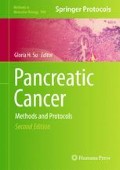Abstract
In mucins, glycosylation is complex and the most predominant posttranslational modification. Since mucins exhibit differential glycosylation pattern under physiological and pathological conditions, analysis of mucin glycans is important for understanding their specific functions during pathological conditions like cancer. Given the complexity of mucin glycans, several sophisticated analytical tools such as HPLC, mass spectrometry, and lectin sandwich assays are employed for glyco-analysis of mucins. However the specialized expertise and instrumentation required for such analysis are beyond the reach of an average cancer biology laboratory. We described in this chapter the utility of the simple electrophoresis/immunoblotting method to examine the mucin glycan epitopes, using specific antibodies and lectins.
Access this chapter
Tax calculation will be finalised at checkout
Purchases are for personal use only
References
Kufe DW (2009) Mucins in cancer: function, prognosis and therapy. Nat Rev Cancer 9:874–885
Moniaux N, Andrianifahanana M, Brand RE, Batra SK (2004) Multiple roles of mucins in pancreatic cancer, a lethal and challenging malignancy. Br J Cancer 91:1633–1638
Rachagani S, Torres MP, Moniaux N, Batra SK (2009) Current status of mucins in the diagnosis and therapy of cancer. Biofactors 35:509–527
Ponnusamy MP, Lakshmanan I, Jain M, Das S, Chakraborty S, Dey P, Batra SK (2010) MUC4 mucin-induced epithelial to mesenchymal transition: a novel mechanism for metastasis of human ovarian cancer cells. Oncogene 29:5741–5754
Senapati S, Chaturvedi P, Chaney WG, Chakraborty S, Gnanapragassam VS, Sasson AR, Batra SK (2011) Novel INTeraction of MUC4 and galectin: potential pathobiological implications for metastasis in lethal pancreatic cancer. Clin Cancer Res 17:267–274
Belisle JA, Horibata S, Jennifer GA, Petrie S, Kapur A, Andre S, Gabius HJ, Rancourt C, Connor J, Paulson JC, Patankar MS (2010) Identification of Siglec-9 as the receptor for MUC16 on human NK cells, B cells, and monocytes. Mol Cancer 9:118
Senapati S, Das S, Batra SK (2010) Mucin-interacting proteins: from function to therapeutics. Trends Biochem Sci 35:236–245
Kinlough CL, Poland PA, Gendler SJ, Mattila PE, Mo D, Weisz OA, Hughey RP (2011) Core-glycosylated mucin-like repeats from MUC1 are an apical targeting signal. J Biol Chem 286(45):39072–39081
Schägger H (2006) Tricine–SDS-PAGE. Nat Protoc 1:16–22
Warren CM, Krzesinski PR, Greaser ML (2003) Vertical agarose gel electrophoresis and electroblotting of high-molecular-weight proteins. Electrophoresis 24:1695–1702
Burdick MD, Harris A, Reid CJ, Iwamura T, Hollingsworth MA (1997) Oligosaccharides expressed on MUC1 produced by pancreatic and colon tumor cell lines. J Biol Chem 272:24198–24202
Argüeso P, Guzman-Aranguez A, Mantelli F, Cao Z, Ricciuto J, Panjwani N (2009) Association of cell surface mucins with galectin-3 contributes to the ocular surface epithelial barrier. J Biol Chem 284(34):23037–23045
Acknowledgments
The authors on this work are supported, in part, by grants from the Department of Defense (BC074639, BC083295, and BC09742) and the National Institutes of Health (RO1 CA78590, EDRN UO1 CA111294, RO1 CA133774, RO1 CA131944, SPORE 50 CA127297 and U54 CA163120).
Author information
Authors and Affiliations
Corresponding author
Editor information
Editors and Affiliations
Rights and permissions
Copyright information
© 2013 Springer Science+Business Media, LLC
About this protocol
Cite this protocol
Gnanapragassam, V.S., Jain, M., Batra, S.K. (2013). Analysis of Tumor-Associated Mucin Glycotopes by Western Transfer Methods. In: Su, G. (eds) Pancreatic Cancer. Methods in Molecular Biology, vol 980. Humana Press, Totowa, NJ. https://doi.org/10.1007/978-1-62703-287-2_19
Download citation
DOI: https://doi.org/10.1007/978-1-62703-287-2_19
Published:
Publisher Name: Humana Press, Totowa, NJ
Print ISBN: 978-1-62703-286-5
Online ISBN: 978-1-62703-287-2
eBook Packages: Springer Protocols

